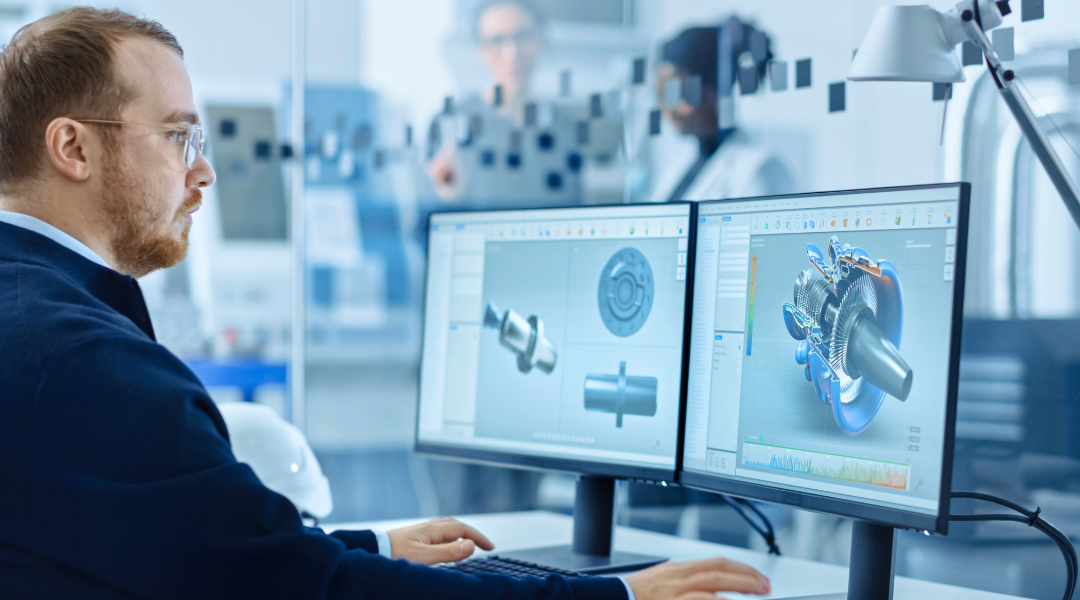From pencil and paper to sophisticated digital tools, the world of design has evolved immensely. At the forefront of this revolution is computer aided design (CAD) software, empowering designers and engineers to create intricate models, visualize products in stunning detail, and optimize designs for manufacturing. Join us as we discuss the different types of CAD software and highlight their wide-ranging applications in industries where precision and innovation are non-negotiable.
Stay Ahead of Supply Chain Issues with Our Helpful Infographic!
What is CAD?
Computer aided design (CAD) is a technology that revolutionizes the design process by using computer software to create, modify, and optimize digital models of physical products. With CAD software, it’s possible to draft precise and detailed drawings, simulate real-world conditions, and visualize designs in three-dimensional space. CAD has replaced traditional manual drafting methods, allowing for faster iterations, improved accuracy, and enhanced productivity.
Types of CAD Software
There are several types of CAD software, each with its own set of features and applications for manufacturers. Here are some of the types of CAD in use today:
2D CAD
2D CAD software allows designers to create two-dimensional drawings with precise measurements and annotations. In manufacturing, 2D CAD is crucial for creating detailed manufacturing drawings and schematics, aiding in the production of components and assemblies.
3D CAD
3D CAD software provides a more immersive and realistic representation of products by creating three-dimensional models. It allows designers to visualize their designs from different angles, simulate real-world conditions, and detect potential issues before manufacturing.
2D/3D Hybrid CAD
Combining the capabilities of both 2D and 3D CAD software, the 2D/3D hybrid approach allows designers to create detailed 2D drawings while having the ability to switch to 3D mode for visualization and analysis. This approach is beneficial for industries that require both detailed drawings and 3D representation, such as manufacturing and architecture.

2D/3D hybrid CAD is one of the types of CAD that make it easier to conceptualize designs
3D Wireframe CAD
Different from traditional 3D CAD software, this type of CAD focuses on creating geometry using lines and curves rather than solid shapes. It is often used for conceptual designs, layout planning, and initial visualization before transitioning to solid or surface modeling. In engineering, 3D wireframe CAD aids in the conceptualization and visualization of initial designs, providing a foundation for more detailed 3D modeling and development.
Solid Modeling CAD
Solid modeling CAD software represents objects as complete, solid entities with volume. It allows designers to create realistic and detailed 3D models by defining their geometric shapes. Thus, it is extremely valuable for designing machine components, tooling, and other precision parts.
Surface Modeling CAD
Surface modeling CAD focuses on creating complex curved surfaces, such as those found in automotive exteriors or aerodynamic designs. It allows designers to define and manipulate surfaces independently of their solid volume. Industries like automotive, aerospace, and industrial design benefit from surface modeling CAD.
Parametric CAD
Parametric CAD software uses mathematical parameters to define and control the design’s dimensions, features, and relationships. It allows designers to create intelligent models that can be easily modified and updated. Parametric CAD is extensively used in engineering, manufacturing, and product development, providing a powerful toolset for creating adaptable and configurable designs for a wide range of products and components.
Direct Modeling CAD
Unlike traditional parametric modeling, direct modeling CAD allows designers to modify models directly without relying on a predefined design history or parameters. It offers flexibility and ease of use when working with complex or imported models. In manufacturing, direct modeling CAD enables rapid design changes to imported models, aiding in the modification of components and tooling.

The types of CAD an engineer uses can change depending on what the specific project requires.
How These Types of CAD Benefit the Manufacturing Industry
The adoption of CAD software brings numerous benefits to manufacturers and engineers. Firstly, CAD software enhances productivity by automating repetitive tasks and providing tools for fast and accurate design modifications. Designers and engineers can focus more on innovation and problem-solving rather than spending time on manual drafting or redesigning.
Secondly, CAD software enables design optimization through prototyping. With tools like parametric modeling and simulation, designers can refine their designs, improve performance, and reduce material waste. This helps in achieving cost-effectiveness and sustainability in manufacturing processes.
CAD software also enhances collaboration and communication among cross-functional teams. Design files can be easily shared, reviewed, and revised, enabling seamless collaboration between designers, engineers, and manufacturing personnel. This eliminates misunderstandings and ensures everyone is working towards the same goal.
Empower Your Operations with These Different Types of CAD
CAD software is an invaluable tool that revolutionizes the manufacturing industry. By understanding the different types of CAD software and their applications, manufacturers can unlock new possibilities for creativity, efficiency, and precision.
If you’re looking for a reliable partner in precision machining and fabrication, Winndeavor is here to help. With our state-of-the-art facility and extensive capabilities in CNC machining, turning, milling, and more, we are committed to delivering top-quality machining that meets the tightest tolerances.
Contact us today to learn more about our services and how we can contribute to your manufacturing projects. Let Winndeavor be your trusted supplier for all your precision machining needs.


